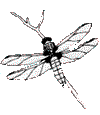
Mayford Heritage Pond

Dragonflies
For such a small, fairly isolated site, the pond has to date attracted 13 species of this beautiful insect, of which 9 have been observed laying eggs.
The most obvious of these are the electric blue Broad-bodied Chaser that tears around the pond like a spitfire, and Britain's largest dragonfly, the Emperor.
Also present are the bright red Common and Ruddy Darters, Brown and Southern Hawkers, and several damselflies such as Azure, Blue-tailed, Large Red, and Red-eyed. The lucky visitor may even find a Banded Demoiselle.
Dragonflies were once known as Horse Stingers due to their fearsome appearance, and Damselflies were the Devil's Darning-needles because of their brightly-coloured thin bodies.
| English Name | Scientific Name | National Status | Comments |
|---|---|---|---|
| Beautiful Damoiselle | Calopteryx virgo | Common | Rare visitor |
| Banded Demoiselle | Calopteryx splendens | Common | Occasional visitor |
| Large Red Damselfly | Pyrrhosoma nymphula | Common | Breeding |
| Azure Damselfly | Coenagrion puella | Common | Breeding |
| Blue-tailed Damselfly | Ischnura elegans | Common | Breeding |
| Common Blue Damselfly | Enallagma cyathigerum | Common | Breeding |
| Red-eyed Damselfly | Erythromma najas | Local | Occasional visitor |
| Southern Hawker | Aeshna cyanea | Common | Breeding |
| Brown Hawker | Aeshna cyanea | Common | Visitor |
| Migrant Hawker | Aeshna mixta | ||
| Emperor Dragonfly | Anax imperator | Common | Breeding |
| Broad-bodied Chaser | Libellula depressa | Common | Breeding |
| Common Darter | Sympetrum striolatum | Common | Breeding |
| Ruddy Darter | Sympetrum sanguineum | Local | Breeding |